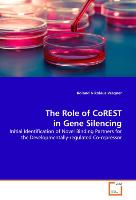- Start
- The Role of CoREST in Gene Silencing
The Role of CoREST in Gene Silencing
Angebote / Angebote:
In eukaryotic organisms a variety of DNA-protein, as well as protein-protein interactions organize in an elaborated way to elicit proper regulation of differential gene expression critical for developmental processes including neurogenesis. Gene silencing induced by the generation of an inactive chromatin state is becoming increasingly appreciated as an important mechanism of transcriptional regulation. CoREST was initially identified as REST-associated protein that mediates transcriptional repression by recruitment of distinct multisubunit complexes implicated in the modification of chromatin. In contrast to REST, which is expressed primarily in non-neuronal cells, CoREST is detected ubiquitously in a variety of neural and non-neural cells in adult tissues. The differential expression pattern of REST and CoREST during development and adulthood suggests REST-independent functions of CoREST. It is likely that CoREST is recruited to specific DNA sites by various transcription factors, of which REST is perhaps one of many. The various transcription-related factors, identified in the course of the present study as novel CoREST-binding proteins strongly support this hypothesis.
Folgt in ca. 5 Arbeitstagen
